The Be Quiet! Dark Rock Pro 5 CPU Cooler Review: When Less Is More
by E. Fylladitakis on January 16, 2024 10:00 AM EST- Posted in
- Cases/Cooling/PSUs
- be quiet!
- CPU cooler
- Air Cooling
Testing Results, Maximum Fan Speed
To begin with, we are having a look at the Be Quiet! Dark Rock Pro 5 with its stock fans running at their maximum speed.
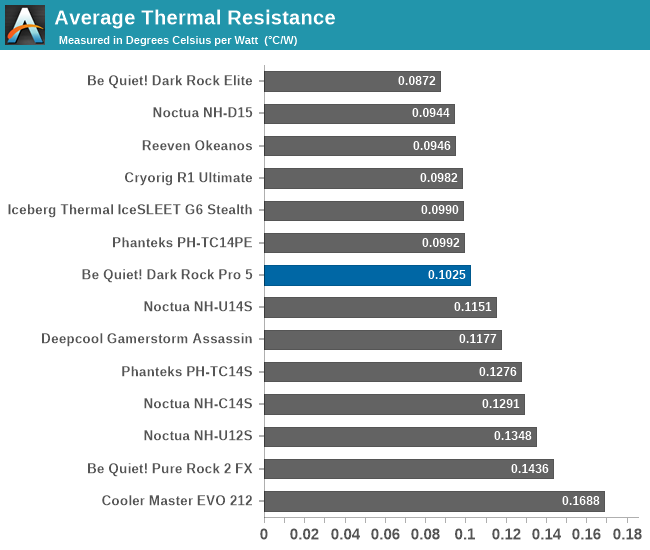
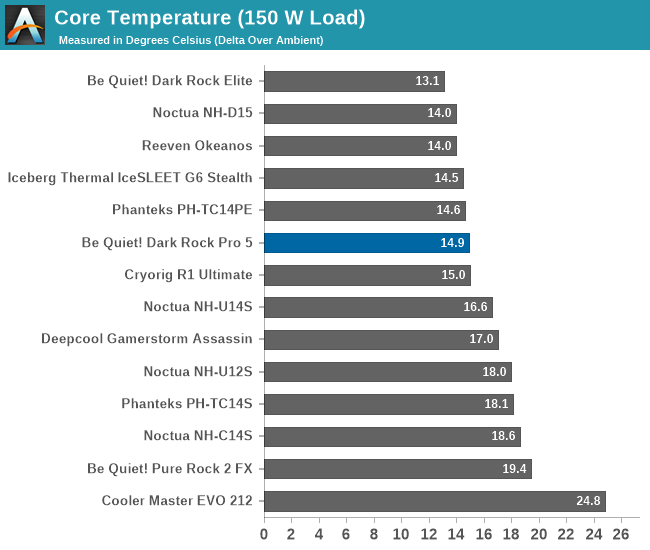
| Core Temperature, Constant Thermal Load (Max Fan Speed) |
The Be Quiet! Dark Rock Pro 5 exhibits a very good average thermal resistance of 0.1025 °C/W at its maximum fan speed of 1700 RPM. This efficiency is particularly notable under higher loads, aligning with its design geared towards handling demanding CPU applications. At first sight, it appears as if it falls significantly behind the Dark Rock Elite in terms of thermal performance but we need to remember that the Dark Rock Pro 5 has significantly slower fans installed.
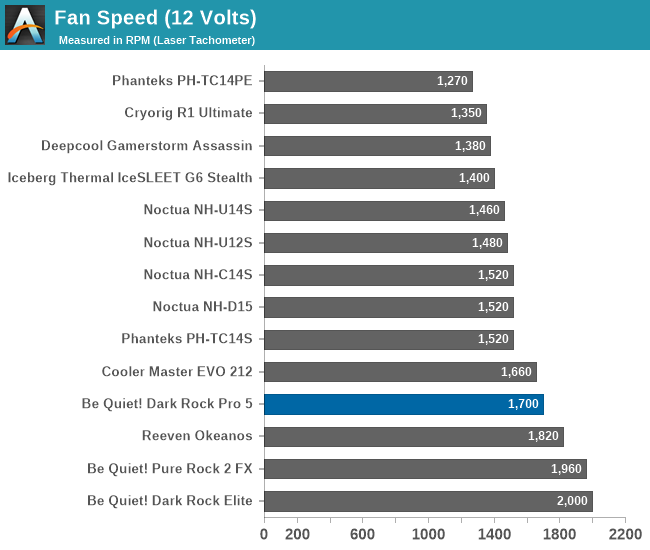
The cooler's Silent Wings PWM fans are engineered to maintain low noise levels during peak operation. At full speed, the Dark Rock Pro 5 generates a noise level of approximately 36.6 dB(A). This level of noise, while not entirely silent, is remarkably low for a cooler operating with two fans, reflecting Be Quiet!'s commitment to balancing cooling performance with reduced acoustic output.
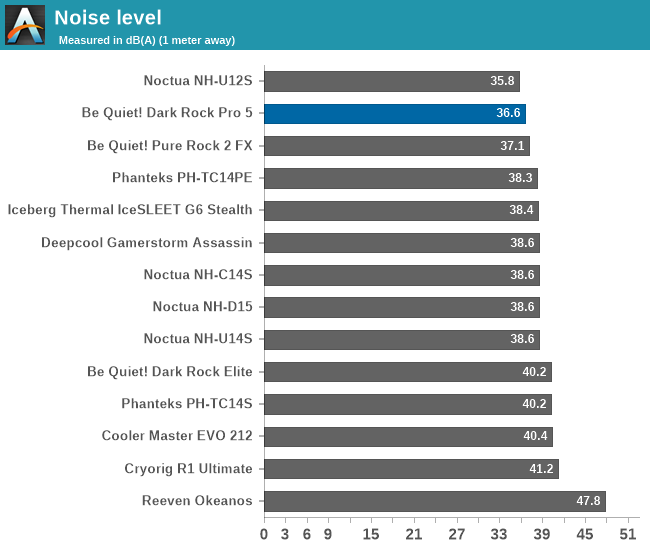
Testing Results, Low Fan Speed
In this test we are switching things up a bit, taking a look at the cooler’s performance with the Silent Wings fans taken down to half speed.

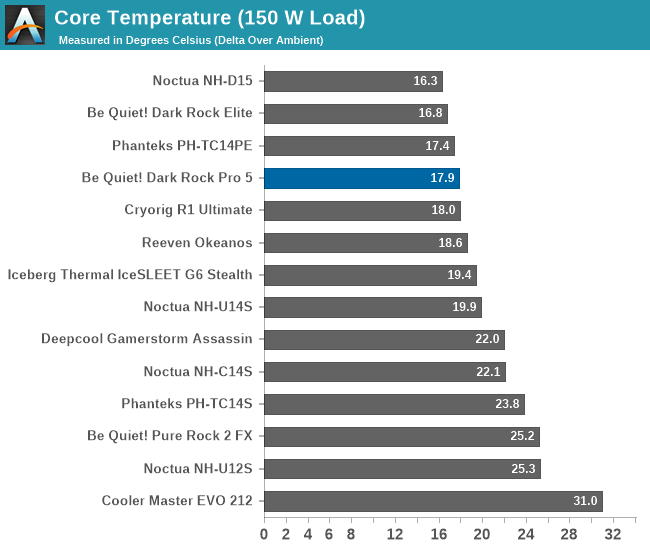
| Core Temperature, Constant Thermal Load (Low Fan Speed) |
When the fan speed of the Be Quiet! Dark Rock Pro 5 is reduced to 850 RPM, there is an expected decrease in thermal performance. The average thermal resistance at this reduced speed is measured at 0.1301 °C/W. Although this thermal performance is more than adequate for daily usage, it has the Dark Rock Pro 5 falling behind many competitive solutions in terms of raw thermal performance. Once again, we need to take into account the low speed of the cooling fans.
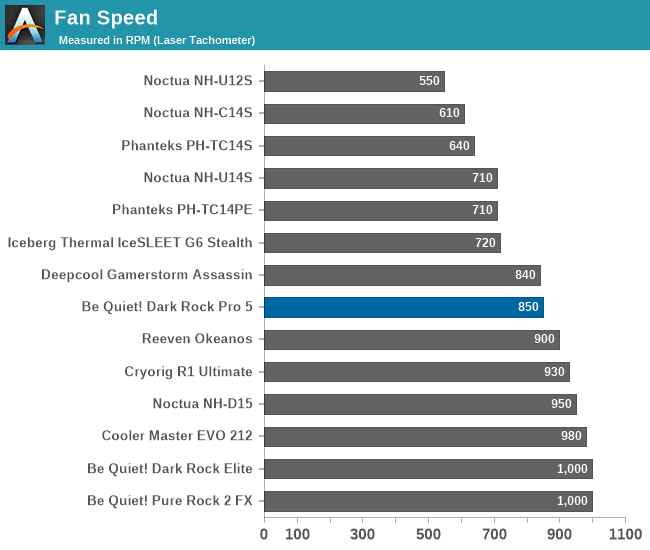
Reducing the speed of the Silent Wings PWM fans to half results in a massive decrease in noise output, dropping to 32 dB(A). At this noise level, the cooler is practically inaudible, making it noticeable only in extremely quiet settings where no other noise sources are present and with the observer very close to the cooler. Under realistic operating conditions, it would be nearly impossible to discern the noise coming from the Dark Rock Pro 5, even in a dead-quiet environment.
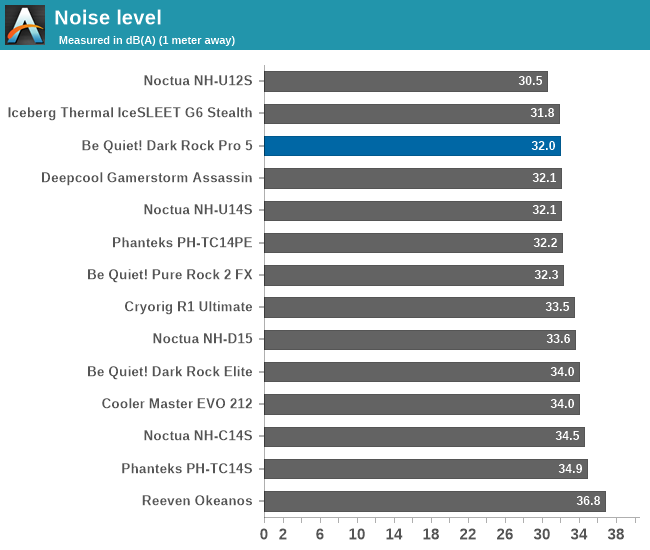
Thermal Resistance VS Sound Pressure Level
During our thermal resistance vs. sound pressure level test, we maintain a steady 100W thermal load and assess the overall performance of the coolers by taking multiple temperature and sound pressure level readings within the operating range of the stock cooling fans. The result is a graph that depicts the absolute thermal resistance of the cooler in comparison to the noise generated. For both the sound pressure level and absolute thermal resistance readings, lower figures are better.
Out thermal resistance versus SPL chart is highly illuminating regarding the overall performance of the Dark Rock Pro 5, especially in relation to its mightier Dark Rock Elite version. The Dark Rock Pro 5 has almost exactly the same noise-to-performance ratio as the Dark Rock Elite, with the sole exception of having a slightly lower operating range. Simply put, the Dark Rock Pro 5 can operate more quietly but cannot reach as high a thermal performance as the Dark Rock Elite. For the most part of their operational range, the two coolers have nearly identical performance. This was not unexpected, taking into account that both coolers share the same body and only their fans change.


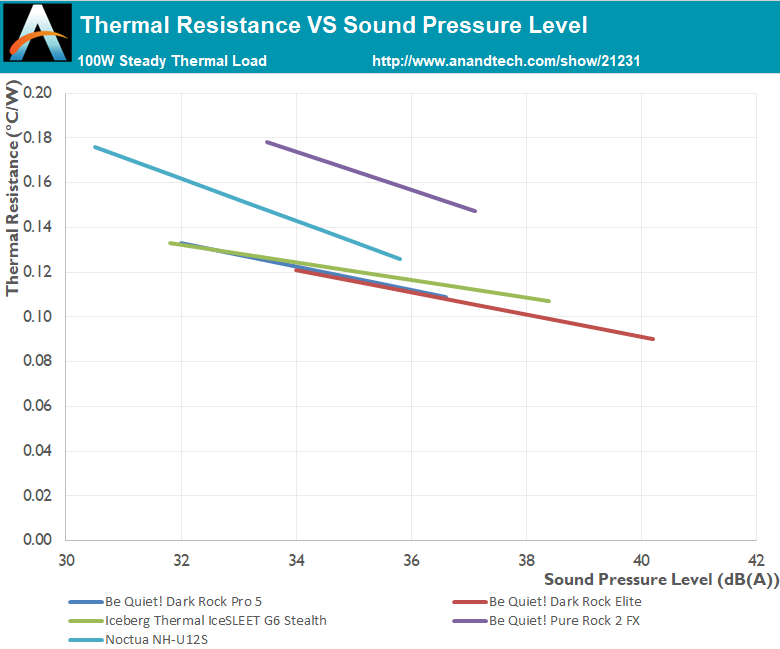








20 Comments
View All Comments
Footman36 - Tuesday, January 16, 2024 - link
Appreciate the review. $80 is still ridiculously expensive for a HSF when you can buy the Thermalright Phantom Spirit for $33 and get similar performance. I would like to see a review of this HSF on Anandtech.PeachNCream - Sunday, January 21, 2024 - link
I get and support where you're coming from. A good condition used laptop can sink you for under $200 (new laptops start at around that price as well though adequate future proofing is more or less a $400 laptop) and for your $80 here you get a single component that doesn't compute anything on its own that you have to be bothered to put together yourself. What a waste! But also, in fairness, that DIY segment is collapsing as we learn we can just use a phone we already own or carry our computer anywhere in the form of a power-efficient and inexpensive laptop so prices relative to inflation have fallen a bit lately so $80 isn't all that bad these days. Still though, I agree with you that it's an utterly stupid venture to go purchasing an overpriced, non-movable desktop PC more than 20 years in to this century and most of the world agrees if you look at sales of hardware.RLees - Sunday, January 21, 2024 - link
Well, perhaps true for your use case -- but you'll pry my fixed gaming PC out of my cold dead hands.Sure I =could= get a laptop with an external GPU but when I looked at that I ended up with a very large laptop with all kinds of luggability issues -- so stayed with my desktop and thin/light laptop solution with no compromises for either use case.
PeachNCream - Sunday, January 21, 2024 - link
Gaming laptop? Those are a huge waste of money and effort as well. There really is no need for a dGPU of any sort if you use a bit of selectivity in the types of things you use your computer for although, I do understand a lot of people don't know any better and are sedentary being a computer screen for a substantial number of hours of their lives. I hope you can find other ways to have fun someday.nubie - Tuesday, January 16, 2024 - link
How does this compare to a budget cooler like the 7-pipe Phantom Spirit? At half the price I am willing to bet it is still swinging. You could upgrade to Noctua fans and still be in the same ballpark for noise and performance. I suppose the looks are "pedestrian", but I don't drive a bro-dozer either.mode_13h - Thursday, January 18, 2024 - link
Thank you for including the Noctua NH-C14S in your testing. Since I like downdraft coolers, I appreciate having more data on it and how it compares to other popular models.krazyfrog - Friday, January 19, 2024 - link
I'm not sure I get the point of an arbitrary 50% value for the low fan speed test when all models are going to be at different RPM and noise levels. What exactly is so special about the 50% value for it to be the normalization constant? Why not noise normalize instead at a steady decibel level?E.Fyll - Saturday, January 20, 2024 - link
Much like you said, it is an arbitrary point, showing the capacity of the cooler at low airflow.We are doing far better than "normalizing" at a single dB level. Instead, we take measurements at several levels and compose the TRvsSPL chart. It shows the capacity of every cooler across its entire operational range and how airflow affects its performance (slope). If I were, for example, to set a "standard" dB level, there would undoubtedly be cases where the cooler would not be able to operate there at all. Check this review's chart for example. If I chose 33 dB(A) as the "normalized level", the Dark Rock Elite would not be able to reach it. If I chose 36 dB(A), the NH-U12S could not reach that. There would be chaos across the reviews. It would be far easier and faster for me to test a single point rather than taking multiple measurements and generating the graph but that is just bad practice.
RLees - Sunday, January 21, 2024 - link
The 1st image on the last page appears to be the Dark Rock Pro 4 cooler, not 5.Correct?
Ryan Smith - Monday, January 22, 2024 - link
No, that is the DRP 5. All of these photos were taken at the same time. (Plus we don't even have a DRP 4)